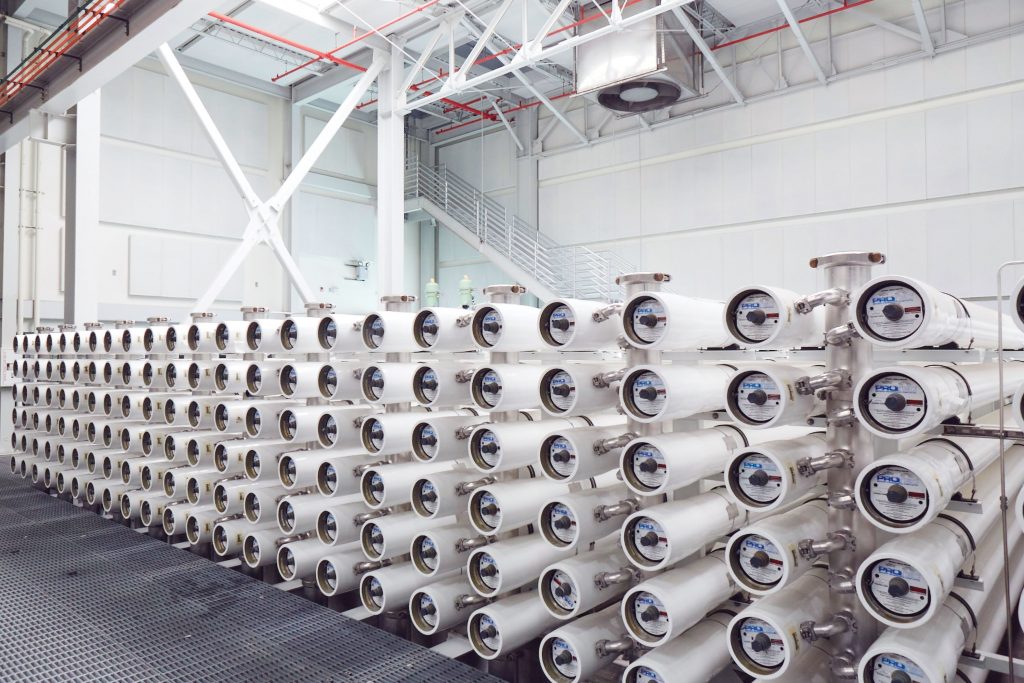
Orange County is home to the world’s largest water purification system for indirect potable reuse—and it’s only getting bigger. The Groundwater Replenishment System (GWRS), a joint project between Orange County Water District and Orange County Sanitation District, just finished its final expansion. We spoke to OCWD General Manager Mike Markus and the group’s recent president, Steve Sheldon, to learn more about this revolutionary facility.
Where does our water come from, and how does the replenishment system fit into the picture?
Markus: The main sources of water that recharge the Orange County Groundwater Basin are flows from the Santa Ana River, local rainfall, imported water, and water from the GWRS.
How much water comes from the GWRS?
Sheldon: It’s quite impressive the amount of water we’re delivering to the county. Before this expansion, we provided 100 million gallons of water each day, which is enough for around 850,000 people. With this final expansion that is set to go online this winter, the GWRS will provide 130 million gallons of water per day, which is enough for about a million people.
When was the system created?
Markus: It opened in its initial state in 2008. We began looking at developing the concept for this project and getting it approved in the mid-’90s. The first phase was a $481 million project, and it was on a scale that had never been done before. The initial expansion in 2015 was another $142 million.
Sheldon: There were a lot of naysayers at the (beginning). “It’s going to be too expensive.” “It’s a risk.” But it was a good risk.
Markus: There was a term coined at the time, “Toilet to Tap,” and opponents to these types of projects used that as a type of scare tactic. But we were successful. One of the first things the board did was hire a public affairs firm. We did outreach; we did polling; we did focus groups. We got letters of support from all the retail water agencies and the city councils. We had the environmental community behind us—Surfrider, Coastkeeper, Sierra Club—they all supported the project. We did outreach to the underserved communities. We gave more than 1,200 presentations over a 10-year period. We ended up with no active opposition on the project. And we continue that outreach to this day.
Where does the water for the GWRS come from?
Sheldon: We’re really blessed to have the Orange County Sanitation District right next door (to the replenishment system facility in Fountain Valley).
Markus: (The sanitation district) will treat the domestic and industrial wastewater to a degree where they can safely discharge it into the ocean. But instead of doing that, we intercept that water and bring it into our facility and treat it with our advanced purification process so that it exceeds all the parameters to make it safe to drink. We view wastewater not as a waste but as a resource. Once we get our final expansion online (which cost another $310 million), we will be recycling 100 percent of the sanitation district’s recyclable flows. So that is an accomplishment where, I don’t know that there’s anyone else who can say that. Certainly not for potable reuse.
How is the water treated?
Markus: There are three main steps—microfiltration, reverse osmosis, and ultraviolet light with hydrogen peroxide. Microfiltration gets rid of any bacteria, protozoa, and suspended solids that go through the treatment process. Reverse osmosis removes the dissolved minerals, viruses, and pharmaceuticals. There are some very small contaminants that can get through reverse osmosis, and that’s when the ultraviolet light and hydrogen peroxide come in. By the time we get done with the water, it’s as pure as distilled water.

Does all of that water go into refilling the groundwater basin?
Markus: Most of it goes up a 13-mile pipeline we built along the Santa Ana River to two recharge basins we have in Anaheim. Those recharge basins percolate water into the groundwater basin. But some of the water produced by the GWRS goes into the seawater barrier—a series of wells we have along Ellis Avenue that we have to inject with freshwater to keep the seawater from flowing in and contaminating the groundwater basin.
What makes the GWRS unique? Why don’t other places do what you do?
Sheldon: Not every jurisdiction is so fortunate to have a large groundwater basin. And of course it’s a major investment.
Markus: We’ve won more than 80—probably over 100 at this point—awards for innovation, and we’ve been highly successful. Organizations from around the world are definitely looking at what we’re doing here and hoping to replicate it. And we are actively helping them and advising them.
Read More from our February 2023 H2OC Issue:
- H2OC: How water works in Orange County
